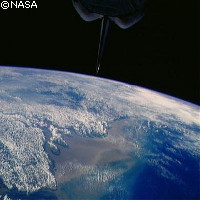Researchers reconstruct Amazon River history
Researchers from Brazil, the Netherlands and the UK have shed new light on the history of the Amazon River. Published in the journal Geology, their findings indicate that the Amazon River emerged as a transcontinental river some 11 million years ago and developed into its current shape almost 2.4 million years ago. The researchers from the oil group Petroleo Brasileiro SA (Petrobras), the Institute for Biodiversity and Ecosystem Dynamics (IBED) at the University of Amsterdam in the Netherlands, and the University of Liverpool in the UK used new subsurface data from two boreholes drilled around the mouth of the Amazon River to reconstruct the history of the Amazon River. They already knew that the age of the river was Late Miocene (between 11 million to 5 million years), but thanks to their work they were able to narrow it down to between 11.8 and 11.3 million years. 'The Amazon River is quite a youngster among rivers,' explained Dr Jorge J. P. Figueiredo of Petrobras, who is currently working as a researcher at the University of Liverpool. 'For comparison, the River Meuse or the River Nile are several hundreds of millions years old.' The reason for this difference is the source area, he stated. 'Rivers are as old as the mountains in the hinterland,' Dr Figueiredo said. 'The Andes uplifted mostly in the past 12 million years, and hence the formation of the Amazon and the shifting of draining patterns. 'Prior to the transcontinental river, a precursor, smaller river (a pre-transcontinental Amazon river) - that dates back to early Miocene (between 23 million to around 16 million years ago) - flowed in the eastern portion of the Amazon region into the Atlantic Ocean,' he said. 'It was this river that [...] some 11 million years ago connected with the wetland existing in the western portion of the Amazon region to form a draining system that connects the Andes to the Atlantic Ocean.' The river's current shape was formed nearly 2.4 million years ago because of the climate change and onset of the ice age. 'This brought down a huge amount of sediment through the river into the ocean,' Dr Figueiredo said. 'Presently we are in an interglacial [period] and the sediment load to the ocean would be less than it was throughout the ice ages (i.e. up to Holocene [approximately the last 10 000 years])'. The Amazon Fan, the world's third largest modern mud-rich submarine fan system, is a sediment column of around 10 kilometres in thickness. Drilling expeditions in the past failed to provide sedimentological and paleontological information from such depths. However, this latest study has provided insight into the history of the Amazon River and Fan. The researchers were able to study the origin of the sediment and fossil content, and assess the contacts between layers in the subsurface. 'The reconstruction was made by comparing the marine and continental records,' Dr Figueiredo explained. 'Together, they complement each other and permit us to reconstruct the story, like detectives.' According to the researchers, sediment aprons that are located near major rivers contain key records of terrestrial material accumulated by the river over time. The information obtained in this study is groundbreaking and will help fuel cooperation between academia and industry. So what does the future hold? Dr Figueiredo commented that it depends on the scale of the analysis. 'On a scale of hundreds or even thousands of years, the future of the Amazon River is linked to the consequences of global warming,' he pointed out. 'In case of a rise in sea level, as a consequence of the meltdown of the ice sheet in the poles, there will be flooding beyond the present overbanks of the river. Forecasting what could happen on a scale of millions of years gets trickier. 'In this case, the future of the river is linked to the geotectonic evolution of the South American plate in its [migration] westward, and consequently [to] the future evolution of the Andean cordillera and climate changes on a longer term scale than the glacial/interglacial periods,' he said.
Countries
Netherlands, United Kingdom



